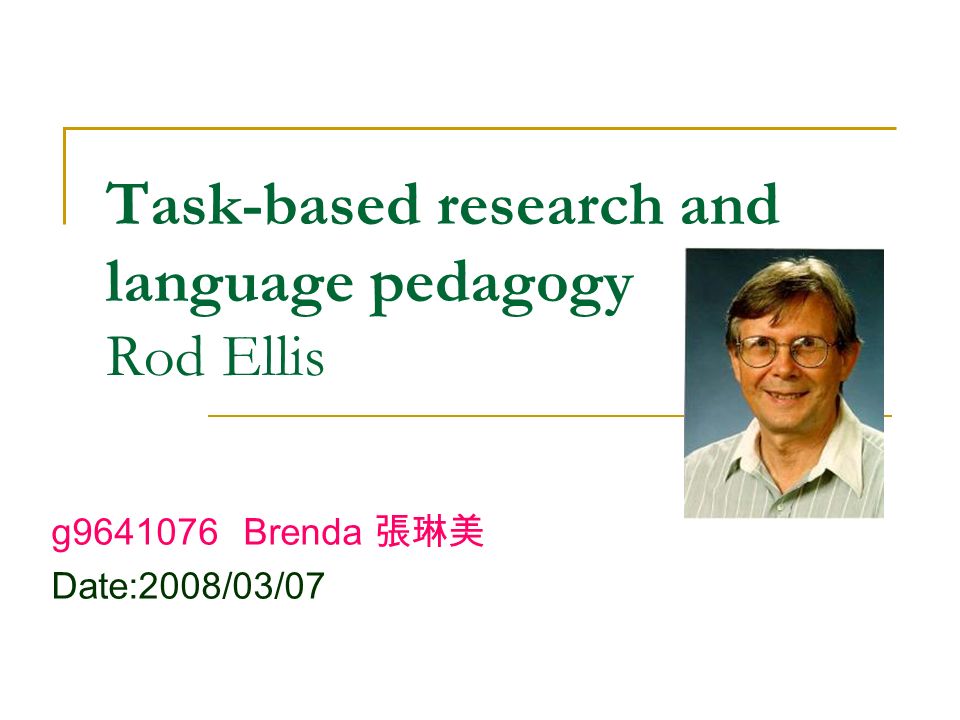
Task Based Language Learning And Teaching Rod Ellis 2003 Pdf Download Free
Task-based language teaching ( TBLT), also known as task-based instruction ( TBI), focuses on the use of authentic language and on asking students to do meaningful tasks using the target language. Such tasks can include visiting a doctor, conducting an interview, or calling customer service for help. Assessment is primarily based on task outcome (in other words the appropriate completion of real world tasks) rather than on accuracy of prescribed language forms.
Hronometrazh rabochego dnya buhgaltera primer. Dive Trip Date: HKBgPKVv Information_Provided_by: TyjrhXkvk Email: newas@gmail.com Visibility: wZEpEzGwXxWWSNwozfs Surface Water Temp: dGDxTQlXQctE Thermalcline Water Temp: SKqOLgekJPocjbHGU.
Download by rod ellis task based language learning and teaching oxford applied linguistics 1st ed paperback or read online here in PDF or EPUB. The book shows how research and task-based teaching can mutually inform each other and illuminate the areas of task-based course design, methodology, and assessment. The author brings an accessible style and broad scope to an area of contemporary importance to both SLA and language pedagogy.
This makes TBLT especially popular for developing target language fluency and student confidence. As such TBLT can be considered a branch of (CLT). TBLT was popularized by while working in. Prabhu noticed that his students could learn language just as easily with a non-linguistic problem as when they were concentrating on linguistic questions. Major scholars who have done research in this area include, Martin East.
Contents • • • • • • • • • • • • • Background [ ] Task-based language learning has its origins in, and is a subcategory of it. Educators adopted task-based language learning for a variety of reasons. Some moved to task-based syllabus in an attempt to make language in the classroom truly communicative, rather than the pseudo-communication that results from classroom activities with no direct connection to real-life situations. Others, like Prabhu in the, thought that tasks were a way of tapping into learners' natural mechanisms for second-language acquisition, and weren't concerned with real-life communication per se. Definition of a task [ ] According to, a task has four main characteristics: • A task involves a primary focus on (pragmatic) meaning. • A task has some kind of ‘gap’ (Prabhu identified the three main types as information gap, reasoning gap, and opinion gap).
• The participants choose the linguistic resources needed to complete the task. • A task has a clearly defined, non-linguistic outcome. In practice [ ] The core of the lesson or project is, as the name suggests, the task. Teachers and curriculum developers should bear in mind that any attention to form, i.e., grammar or vocabulary, increases the likelihood that learners may be distracted from the task itself and become preoccupied with detecting and correcting errors and/or looking up language in dictionaries and grammar references. Although there may be several effective frameworks for creating a task-based learning lesson, here is a basic outline: Pre-task [ ] In the pre-task, the teacher will present what will be expected from the students in the task phase. Additionally, in the 'weak' form of TBLT, the teacher may prime the students with key vocabulary or grammatical constructs, although this can mean that the activity is, in effect, more similar to the more traditional present-practice-produce (PPP) paradigm.
Comment3, Fable 2 rutor, 137, http://www.clanky.knihovna.cz/?Wondershare. We would like to show you a description here but the site won’t allow us. Beginning of dialog window. Escape will cancel and close the window. White Black Red Green Blue Yellow Magenta Cyan. Etain 27.04.16 23:58 comment3, Skachat sbornik. 
In 'strong' task-based learning lessons, learners are responsible for selecting the appropriate language for any given context themselves. The instructors may also present a model of the task by either doing it themselves or by presenting picture, audio, or video demonstrating the task. Task [ ] During the task phase, the students perform the task, typically in small groups, although this depends on the type of activity. Unless the teacher plays a particular role in the task, the teacher's role is typically limited to one of an observer or counselor—thereby making it a more student-centered methodology. [ ] Review [ ] If learners have created tangible linguistic products, e.g. Text, montage, presentation, audio or video recording, learners can each other's work and offer constructive feedback. If a task is set to extend over longer periods of time, e.g.